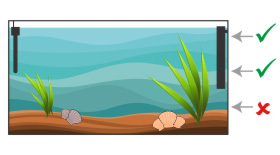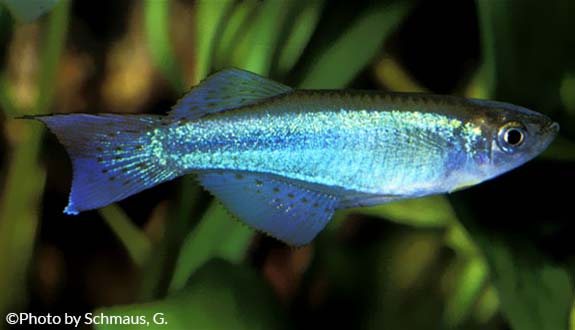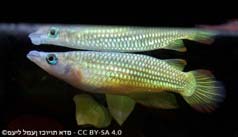

Alternative species (click on the thumbnail to see the card)
Names
Scientific name
Procatopus aberrans
Procatopus andreaseni
Procatopus gracilis
Procatopus nigromarginatus
Procatopus plumosus
Procatopus roseipinnis
Common name
Blue Green lampeye
Bluegreen lampeye
Origin

Origin: Cameroon and Nigeria Luvial Africa
Biotope: African
Dimorphism

The male has longer fins and brighter colours.
Group

Cynolebiidae (Nothobranchiidae)
Volume

120 L / 26 imp gal / 32 US gal
Parameters

T°: 24 to 26°C or 75 to 79°F
pH: 6.5 to 7.3
Hardness: 8 to 20°dGH
Difficulty

Easy
Size

Female: 5cm (2") - Male: 7cm (2.8")
Longevity

4 years
Living zone

Middle and top
Individuals

10
Food
How to feed the Blue Green lampeye?
Food
How to feed the Blue Green lampeye?
The Common Procatopus is a carnivorous fish with an insectivorous tendency. It is easy to feed and eats all kinds of prey such as artemia, worms, larvae, daphnia. They can be fed either live or frozen.
Traditional freeze-dried foods are accepted and will serve as a good complement to the basic diet.
Behavior
What kind of behavior does the Blue Green lampeye have?
Behavior
What kind of behavior does the Blue Green lampeye have?
This small gregarious fish is peaceful with everyone. It has a good character and will not bother the other occupants of your tank. It is even the opposite, it can be shy or even a little shy.
These Killies can fight amongst themselves if they are kept in an aquarium that is too small. To satisfy their gregarious instincts, count a group of at least 10 individuals for an aquarium of at least 120L / 26 Imp Gal / 32 US Gal.
Cohabitation
Who can live with the Blue Green lampeye?
Cohabitation
Who can live with the Blue Green lampeye?
Cohabitation between male Procatopus is to be monitored, but with a sufficiently spacious aquarium and a good male/female ratio, this should not be a problem. For example, a group of 10 fish of this species will only contain a maximum of 2 or 3 males.
Cohabitation with other species does not pose any particular difficulties.
Breeding
How to breed the Blue Green lampeye?
Breeding
How to breed the Blue Green lampeye?
Sexual dimorphism is quite obvious in this species. Indeed, the male has more beautiful colors ranging from blue to metallic green. The female's colours are duller.
The courtship ritual is quite pretty. The male turns around the female with his fins spread out. The female Procatopus can lay her eggs every day. Oviposition usually takes place close to the ground, in fairly deep roots, rocks and cavities. If you do not have caves, it is imperative that your roots or rocks have crevices so that the female can lay her eggs in them.
There is adult predation on the fry. For a larger number of surviving fry, take the eggs (don't worry, they are strong enough and can be handled quite well) and put them to incubate in a separate aquarium (temperature at 25°C/77°F). You can also isolate them in a tank of about 30L / 6 Impg Gal / 8 US Gal (with sand and some deep roots). After egg-laying, remove the parents.
Food for the fry: rotifers, infusers, artemia nauplias.
Its aquarium
Which aquarium for the Blue Green lampeye?
Its aquarium
Which aquarium for the Blue Green lampeye?
It is important to provide an aquarium large enough to accommodate your aberrant Procatopus because they tend to argue if it is too cramped. Plant densely and make many hiding places with rocks and large roots. This will increase the shy fish's sense of security and greatly reduce its stress.
Beware, this species requires clean, well-oxygenated water in order to reproduce its natural habitat as well as possible. Regular water changes will be essential for a correct maintenance of this Killie.
Finally, cover your aquarium well because many aquarists have noticed the jumping talent of this small fish.
Good To know
Find all additional information!
Good To know
Find all additional information!
The procatopus aberrans has beautiful color! To take full advantage of it, opt for a dark floor that will bring out its colouring.
Yours photos!
Comments
Sort by:
Please login to post comments


